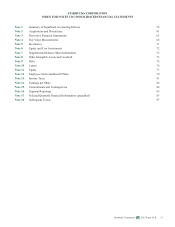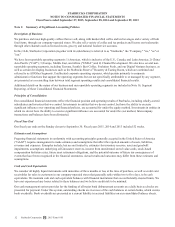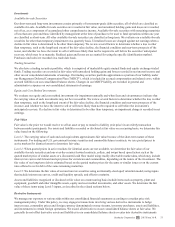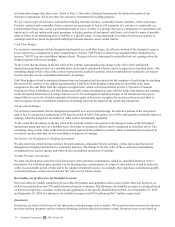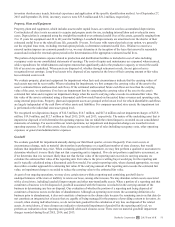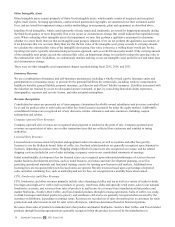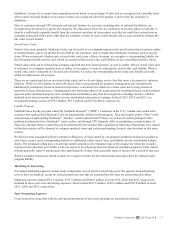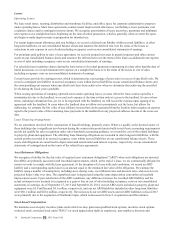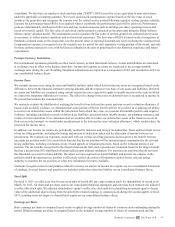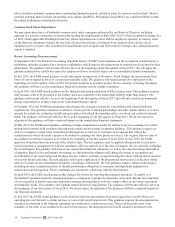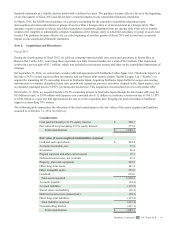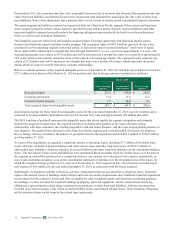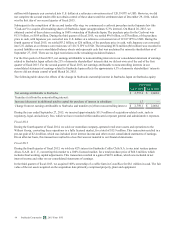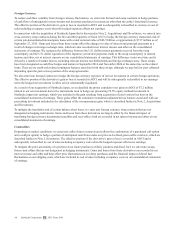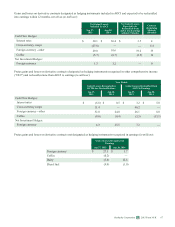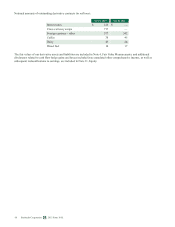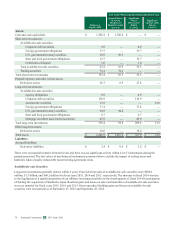Starbucks 2015 Annual Report Download - page 64
Download and view the complete annual report
Please find page 64 of the 2015 Starbucks annual report below. You can navigate through the pages in the report by either clicking on the pages listed below, or by using the keyword search tool below to find specific information within the annual report.
effect of dilutive potential common shares outstanding during the period, calculated using the treasury stock method. Dilutive
potential common shares include outstanding stock options and RSUs. Performance-based RSUs are considered dilutive when
the related performance criterion has been met.
Common Stock Share Repurchases
We may repurchase shares of Starbucks common stock under a program authorized by our Board of Directors, including
pursuant to a contract, instruction or written plan meeting the requirements of Rule 10b5-1(c)(1) of the Securities Exchange Act
of 1934. Under applicable Washington State law, shares repurchased are retired and not displayed separately as treasury stock
on the financial statements. Instead, the par value of repurchased shares is deducted from common stock and the excess
repurchase price over par value is deducted from additional paid-in capital and from retained earnings, once additional paid-in
capital is depleted.
Recent Accounting Pronouncements
In September 2015, the Financial Accounting Standards Board ("FASB") issued guidance on the recognition of adjustments to
preliminary amounts recognized in a business combination, which removes the requirement to retrospectively account for these
adjustments. The guidance will become effective for us at the beginning of our first quarter of fiscal 2017. We will apply the
guidance prospectively and do not expect the adoption will have a material impact on our consolidated financial statements.
In July 2015, the FASB issued guidance on the subsequent measurement of inventory, which changes the measurement from
lower of cost or market to lower of cost and net realizable value. The guidance will require prospective application at the
beginning of our first quarter of fiscal 2018, but permits adoption in an earlier period. We are currently evaluating the impact
this guidance will have on our consolidated financial statements and the timing of adoption.
In April 2015, the FASB issued guidance on the financial statement presentation of debt issuance costs. This guidance requires
debt issuance costs to be presented in the balance sheet as a reduction of the related debt liability rather than an asset. The
guidance will become effective for us at the beginning of our first quarter of fiscal 2017 and will only result in an immaterial
change in presentation of these costs on our consolidated balance sheets.
In February 2015, the FASB issued guidance that changes the evaluation criteria for consolidation and related disclosure
requirements. This guidance introduces evaluation criteria specific to limited partnerships and other similar entities, as well as
amends the criteria for evaluating variable interest entities with which the reporting entity is involved and certain investment
funds. The guidance will become effective for us at the beginning of our first quarter of fiscal 2017. We do not expect the
adoption of this guidance will have a material impact on our consolidated financial statements.
In May 2014, the FASB issued guidance outlining a single comprehensive model for entities to use in accounting for revenue
arising from contracts with customers that supersedes most current revenue recognition guidance. This guidance requires an
entity to recognize revenue when it transfers promised goods or services to customers in an amount that reflects the
consideration to which the entity expects to be entitled in exchange for those goods or services. The original effective date of
the guidance would have required us to adopt at the beginning of our first quarter of fiscal 2018. In July 2015, the FASB
approved an optional one-year deferral of the effective date. The new guidance may be applied retrospectively to each prior
period presented or retrospectively with the cumulative effect recognized as of the date of adoption. We are currently evaluating
the overall impact this guidance will have on our consolidated financial statements, as well as the expected timing and method
of adoption. Based on our preliminary assessment, we determined the adoption will change the timing of recognition and
classification of our stored value card breakage income, which is currently recognized using the remote method and recorded in
net interest income and other. The new guidance will require application of the proportional method and classification within
total net revenues on our consolidated statements of earnings. Additionally, the new guidance requires enhanced disclosures,
including revenue recognition policies to identify performance obligations to customers and significant judgments in
measurement and recognition. We are continuing our assessment, which may identify other impacts.
In April 2014, the FASB issued guidance that changes the criteria for reporting discontinued operations. To qualify as a
discontinued operation under the amended guidance, a component or group of components of an entity that has been disposed
of or is classified as held for sale must represent a strategic shift that has or will have a major effect on the entity's operations
and financial results. This guidance also expands related disclosure requirements. The guidance will become effective for us at
the beginning of our first quarter of fiscal 2016. We do not expect the adoption of this guidance will have a material impact on
our financial statements.
In July 2013, the FASB issued guidance on the financial statement presentation of an unrecognized tax benefit when a net
operating loss carryforward, a similar tax loss, or a tax credit carryforward exists. This guidance requires the unrecognized tax
benefit to be presented in the financial statements as a reduction to a deferred tax asset. When a deferred tax asset is not
available, or the asset is not intended to be used for this purpose, the unrecognized tax benefit should be presented in the
60 Starbucks Corporation 2015 Form 10-K



